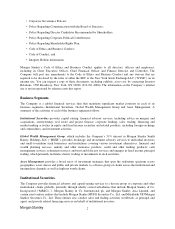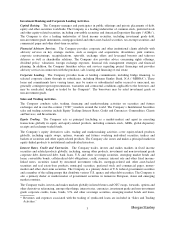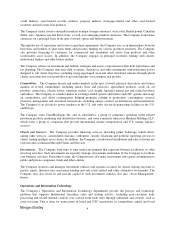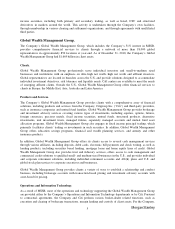Morgan Stanley 2010 Annual Report Download - page 18
Download and view the complete annual report
Please find page 18 of the 2010 Morgan Stanley annual report below. You can navigate through the pages in the report by either clicking on the pages listed below, or by using the keyword search tool below to find specific information within the annual report.
subsidiaries, to implement Basel II standards over the next several years. The timeline set out in December 2007
for the implementation of Basel II in the U.S. may be impacted by the developments concerning Basel III
described below. Starting July 2010, the Company has been reporting on a parallel basis under the current
regulatory capital regime (Basel I) and Basel II, which, as currently scheduled, will be followed by a three-year
transitional period. In addition, under a provision of the Dodd-Frank Act, capital standards generally applicable
to U.S. banks will serve to establish minimum Tier 1 and total capital requirements more broadly, including for
bank holding companies such as the Company that otherwise apply different capital standards set by the Federal
Reserve. In effect, those generally applicable capital standards, which are currently based on Basel I standards
but may themselves change over time, would serve as a permanent floor to minimum capital requirements
calculated under the Basel II standard the Company is currently required to implement, as well as future capital
standards.
Basel III contains new standards that will raise the quality of capital banking institutions must hold, strengthen
the risk-weighted asset base and introduce a leverage ratio as a supplemental measure to the risk-based capital
ratios. Basel III includes a new capital conservation buffer, which imposes a common equity requirement above
the new minimum that can be depleted under stress, subject to restrictions on capital distributions, and a new
countercyclical buffer, which regulators can activate during periods of excessive credit growth in their
jurisdiction. The use of certain capital instruments, such as trust preferred securities, as Tier 1 capital components
will be phased out. Basel III also introduces new liquidity measures designed to monitor banking institutions for
their ability to meet short-term cash flow needs and to address longer-term structural liquidity mismatches.
National implementation of Basel III risk-based capital requirements, including by U.S. regulators, will begin in
2013, and many of the requirements will be subject to extended phase-in periods. Once fully implemented, the
capital requirements would include a new minimum Tier 1 common equity ratio of 4.5%, a minimum Tier 1
equity ratio of 6%, and the minimum total capital ratio which would remain at 8.0% (plus a 2.5% capital
conservation buffer consisting of common equity in addition to these ratios). Despite extended phase-in periods,
the Company expects some of the new capital requirements to become relevant sooner. For example, on
November 17, 2010, the Federal Reserve announced that it will require large U.S. bank holding companies to
submit capital plans that show, among other things, the ability to meet Basel III capital requirements over time,
and the Company submitted its capital plan to the Federal Reserve on January 7, 2011 in response to such
requirements. The Federal Reserve will evaluate capital plans that include a request to increase common stock
dividends, implement stock repurchase programs, or redeem or repurchase capital instruments.
Concurrently with implementing regulations concerning Basel III, U.S. banking regulators will implement
provisions of the Dodd-Frank Act with effect on capital and related requirements, including heightened capital
and liquidity requirements for financial institutions subject to the systemic risk regime, including the Company,
as well as a mandate to make capital requirements countercyclical, and for capital requirements to address risks
posed by certain activities. Pursuant to a provision of the Dodd-Frank Act, over time, trust preferred securities
will no longer qualify as Tier 1 capital but will qualify only as Tier 2 capital. This change in regulatory capital
treatment will be phased in incrementally during a transition period that will start on January 1, 2013 and end on
January 1, 2016. This provision of the Dodd-Frank Act is expected to accelerate the phase-in of disqualification
of trust preferred securities provided for by Basel III.
Bank holding companies are also subject to a Tier 1 leverage ratio as defined by the Federal Reserve. Under
Federal Reserve rules, the minimum leverage ratio is 3% for bank holding companies, including the Company,
that are considered “strong” under Federal Reserve guidelines or which have implemented the Federal Reserve’s
risk-based capital measure for market risk. Basel III introduces internationally a leverage ratio that could result in
more stringent capital requirements than the current minimum U.S. leverage ratio. Bank holding companies such
as the Company, over a period of time will also be required to satisfy, at a minimum, the leverage capital
requirements currently in effect for U.S. banks, which will thereafter serve as an effective floor. Financial
institutions subject to the systemic risk regime under the Dodd-Frank Act, including the Company, will also be
required to meet as yet unspecified heightened prudential standards, including possibly higher leverage capital
requirements.
12
























